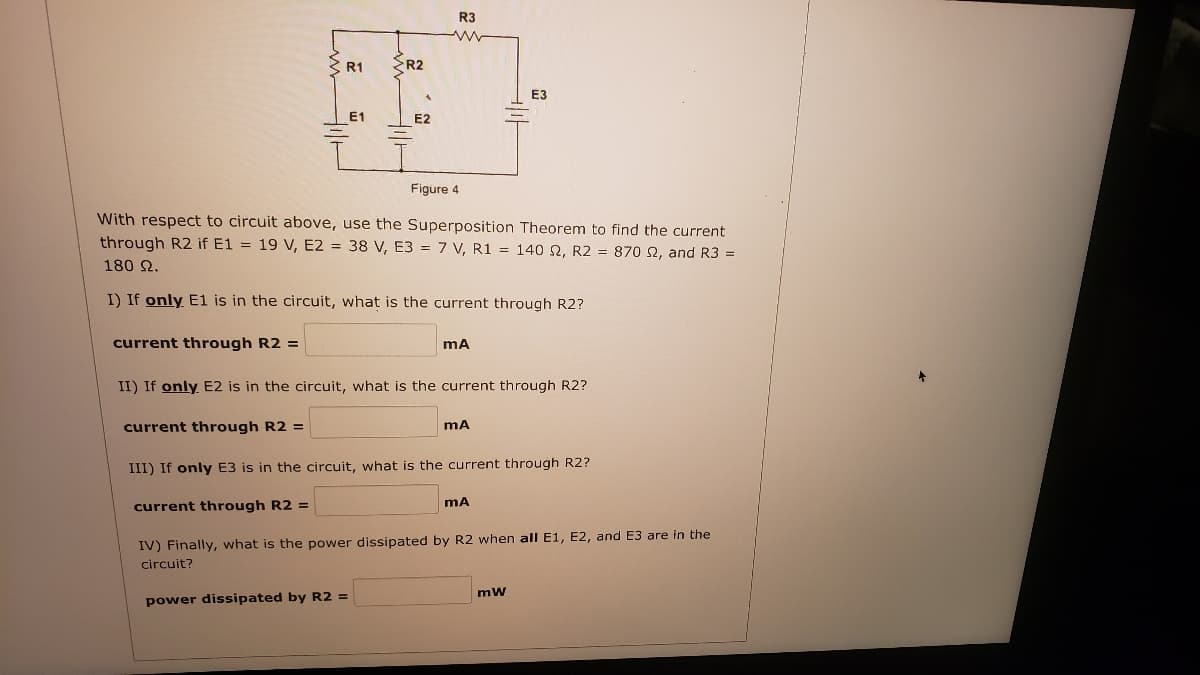R3 R1 R2 ЕЗ E1 E2 Figure 4 With respect to circuit above, use the Superposition Theorem to find the current through R2 if E1 19 V, E2 = 38 V, E3 = 7 V, R1 = 140 N, R2 = 870 2, and R3 = %3D %3D 180 2. I) If only E1 is in the circuit, what is the current through R2? current through R2 = mA II) If only E2 is in the circuit, what is the current through R2? current through R2 = III) If only E3 is in the circuit, what is the current through R2? current through R2 = IV) Finally, what is the power dissipated by R2 when alI E1, E2, and E3 are in the circuit? mw power dissipated by R2 =
R3 R1 R2 ЕЗ E1 E2 Figure 4 With respect to circuit above, use the Superposition Theorem to find the current through R2 if E1 19 V, E2 = 38 V, E3 = 7 V, R1 = 140 N, R2 = 870 2, and R3 = %3D %3D 180 2. I) If only E1 is in the circuit, what is the current through R2? current through R2 = mA II) If only E2 is in the circuit, what is the current through R2? current through R2 = III) If only E3 is in the circuit, what is the current through R2? current through R2 = IV) Finally, what is the power dissipated by R2 when alI E1, E2, and E3 are in the circuit? mw power dissipated by R2 =
Introductory Circuit Analysis (13th Edition)
13th Edition
ISBN:9780133923605
Author:Robert L. Boylestad
Publisher:Robert L. Boylestad
Chapter1: Introduction
Section: Chapter Questions
Problem 1P: Visit your local library (at school or home) and describe the extent to which it provides literature...
Related questions
Question
Round answers to 2 decimal places

Transcribed Image Text:R3
E R1
R2
ЕЗ
E1
E2
Figure 4
With respect to circuit above, use the Superposition Theorem to find the current
through R2 if E1 = 19 V, E2 = 38 V, E3 = 7 V, R1 = 140 2, R2 = 870 2, and R3 =
180 2.
I) If only E1 is in the circuit, what is the current through R2?
current through R2 =
II) If only E2 is in the circuit, what is the current through R2?
current through R2 =
III) If only E3 is in the circuit, whạt is the current through R2?
current through R2 =
IV) Finally, what is the power dissipated by R2 when all E1, E2, and E3 are in the
circuit?
mw
power dissipated by R2 =
Expert Solution
This question has been solved!
Explore an expertly crafted, step-by-step solution for a thorough understanding of key concepts.
Step by step
Solved in 3 steps with 2 images

Knowledge Booster
Learn more about
Need a deep-dive on the concept behind this application? Look no further. Learn more about this topic, electrical-engineering and related others by exploring similar questions and additional content below.Recommended textbooks for you

Introductory Circuit Analysis (13th Edition)
Electrical Engineering
ISBN:
9780133923605
Author:
Robert L. Boylestad
Publisher:
PEARSON

Delmar's Standard Textbook Of Electricity
Electrical Engineering
ISBN:
9781337900348
Author:
Stephen L. Herman
Publisher:
Cengage Learning

Programmable Logic Controllers
Electrical Engineering
ISBN:
9780073373843
Author:
Frank D. Petruzella
Publisher:
McGraw-Hill Education

Introductory Circuit Analysis (13th Edition)
Electrical Engineering
ISBN:
9780133923605
Author:
Robert L. Boylestad
Publisher:
PEARSON

Delmar's Standard Textbook Of Electricity
Electrical Engineering
ISBN:
9781337900348
Author:
Stephen L. Herman
Publisher:
Cengage Learning

Programmable Logic Controllers
Electrical Engineering
ISBN:
9780073373843
Author:
Frank D. Petruzella
Publisher:
McGraw-Hill Education

Fundamentals of Electric Circuits
Electrical Engineering
ISBN:
9780078028229
Author:
Charles K Alexander, Matthew Sadiku
Publisher:
McGraw-Hill Education

Electric Circuits. (11th Edition)
Electrical Engineering
ISBN:
9780134746968
Author:
James W. Nilsson, Susan Riedel
Publisher:
PEARSON

Engineering Electromagnetics
Electrical Engineering
ISBN:
9780078028151
Author:
Hayt, William H. (william Hart), Jr, BUCK, John A.
Publisher:
Mcgraw-hill Education,